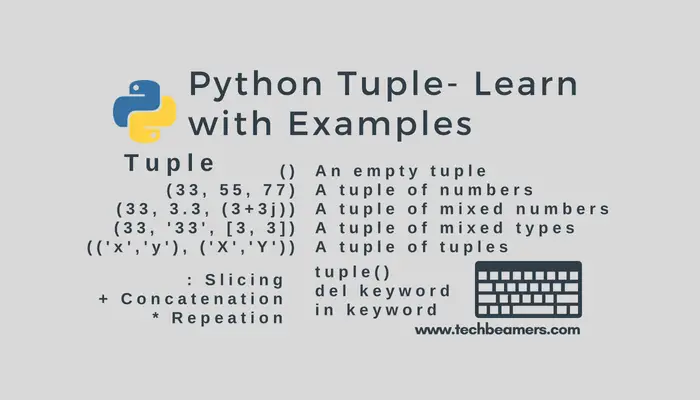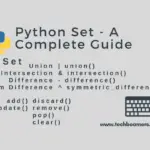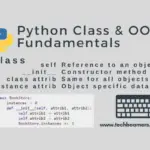In this class, you’ll learn what a Python tuple is, what can you do with it, and how to use it in programs. Moreover, you’ll essentially learn how to create a tuple and perform various operations such as packing, unpacking, slicing, comparison, and deletion.
What is a Tuple in Python?
A Python tuple is a collection-type data structure that is immutable by design and holds a sequence of heterogeneous elements. It functions almost like a Python list but with the following distinctions.
- Tuples store a fixed set of elements and don’t allow changes whereas the list has the provision to update its content.
- The list uses square brackets for opening and closing, whereas a tuple has got parentheses for the enclosure.
A tuple can come in quite handy for programmers in different situations. We’ll discuss them later in this tutorial.
How to instantiate a Tuple in Python?
You can create a tuple by placing a sequence of desired elements separated using commas inside a pair of round brackets (), i.e., parentheses.
Please note that you can create a tuple even without using the parentheses. Also, the elements of a tuple can be of any valid Python data type ranging from numbers, strings, lists, etc.
Let us check out some important examples to create and use tuples in Python.
Create a tuple with different inputs
- Below are various examples of creating tuples with different types of input.
# create an empty tuple
py_tuple = ()
print("A blank tuple:", py_tuple)
# create a tuple without using round brackets
py_tuple = 33, 55, 77
print("A tuple set without parenthesis:", py_tuple, "type:", type(py_tuple))
# create a tuple of numbers
py_tuple = (33, 55, 77)
print("A tuple of numbers:", py_tuple)
# create a tuple of mixed numbers
# such as integer, float, imaginary
py_tuple = (33, 3.3, 3+3j)
print("A tuple of mixed numbers:", py_tuple)
# create a tuple of mixed data types
# such as numbers, strings, lists
py_tuple = (33, "33", [3, 3])
print("A tuple of mixed data types:", py_tuple)
# create a tuple of tuples
# i.e. a nested tuple
py_tuple = (('x', 'y', 'z'), ('X', 'Y', 'Z'))
print("A tuple of tuples:", py_tuple)Executing the above coding snippet will produce the below result.
# output
A blank tuple: ()
A tuple set without parenthesis: (33, 55, 77) type: <class 'tuple'>
A tuple of numbers: (33, 55, 77)
A tuple of mixed numbers: (33, 3.3, (3+3j))
A tuple of mixed data types: (33, '33', [3, 3])
A tuple of tuples: (('x', 'y', 'z'), ('X', 'Y', 'Z'))2. We can invoke the tuple function and get the desired result. See the below example.
# creating a tuple from a set
>>> py_tuple = tuple({33, 55 , 77})
>>> type(py_tuple)
<class 'tuple'>
>>> py_tuple
(33, 77, 55)
# creating a tuple from a list
>>> py_tuple = tuple([33, 55 , 77])
>>> type(py_tuple)
<class 'tuple'>
>>> py_tuple
(33, 55, 77)3. In the below example, we are trying to create a tuple with a single element.
# A single element surrounded by parenthesis will create a string instead of a tuple
>>> py_tuple = ('single')
>>> type(py_tuple)
<class 'str'>
# You need to place a comma after the first element to create a tuple of size "one"
>>> py_tuple = ('single',)
>>> type(py_tuple)
<class 'tuple'>
# You can use a list of one element and convert it to a tuple
>>> py_tuple = tuple(['single'])
>>> type(py_tuple)
<class 'tuple'>
# You can use a set of one element and convert it to a tuple
>>> py_tuple = tuple({'single'})
>>> type(py_tuple)
<class 'tuple'>Also, check out how does Python zip function returns a list of tuples. It is a powerful tool to merge, compare, and iterate lists, tuples, and dictionaries.
Access a tuple in Python
- The simplest is the direct access method where you use the index operator [] to pick an item from the tuple. You can start indexing from the 0th position.
It means if a tuple holds ten elements, then the index will begin at 0th and will end at 9th position. Violating the boundaries of a tuple will result in an IndexError.
Please note that the index is always an integer. You must not try a float or any other form of numbers for indexing purposes. Doing so will produce TypeError.
Next, if the tuple contains other tuples as its elements, then you would need to index the elements tuple-by-tuple.
vowel_tuple = ('a','e','i','o','u')
print("The tuple:", vowel_tuple, "Length:", len(vowel_tuple))
# Indexing the first element
print("OP(vowel_tuple[0]):", vowel_tuple[0])
# Indexing the last element
print("OP(vowel_tuple[length-1]):", vowel_tuple[len(vowel_tuple) - 1])
# Indexing a non-existent member
# will raise the IndexError
try:
print(vowel_tuple[len(vowel_tuple)+1])
except Exception as ex:
print("OP(vowel_tuple[length+1]) Error:", ex)
# Indexing with a non-integer index
# will raise the TypeError
try:
print(vowel_tuple[0.0])
except Exception as ex:
print("OP(vowel_tuple[0.0]) Error:", ex)
# Indexing in a tuple of tuples
t_o_t = (('jan', 'feb', 'mar'), ('sun', 'mon', 'wed'))
# Accessing elements from the first sub tuple
print("OP(t_o_t[0][2]):", t_o_t[0][2])
# Accessing elements from the second sub tuple
print("OP(t_o_t[1][2]):", t_o_t[1][2])After running the above sample code, the following output will be displayed:
# output
The tuple: ('a', 'e', 'i', 'o', 'u') Length: 5
OP(vowel_tuple[0]): a
OP(vowel_tuple[length-1]): u
OP(vowel_tuple[length+1]) Error: tuple index out of range
OP(vowel_tuple[0.0]) Error: tuple indices must be integers or slices, not float
OP(t_o_t[0][2]): mar
OP(t_o_t[1][2]): wed2. Python tuple supports reverse indexing, i.e., accessing elements using the (-ve) index values.
The reverse indexing works in the following manner.
- The index -1 represents the last item.
- An index with value -2 will refer to the second item from the rear end.
Please go through the below example for more clarity.
>>> vowels = ('a','e','i','o','u')
>>> vowels
('a', 'e', 'i', 'o', 'u')
>>> vowels[-1]
'u'
>>> vowels[-2]
'o'
>>> vowels[-5]
'a'
>>> vowels[-6]
Traceback (most recent call last):
File "<pyshell#64>", line 1, in <module>
vowels[-6]
IndexError: tuple index out of range3. If you need to access not one but more than one element from a tuple, then Python’s slicing operator ":" can come to use. Check the code in the following example.
>>> weekdays = ('mon', 'tue', 'wed' ,'thu', 'fri', 'sat', 'sun')
>>> weekdays
('mon', 'tue', 'wed', 'thu', 'fri', 'sat', 'sun')
# accessing elements leaving the first one
>>> weekdays[1:]
('tue', 'wed', 'thu', 'fri', 'sat', 'sun')
# accessing elements between the first and fifth positions
# excluding the ones at the first and fifth position
>>> weekdays[1:5]
('tue', 'wed', 'thu', 'fri')
# accessing elements after the fifth position
>>> weekdays[5:]
('sat', 'sun')
# accessing the first five elements
>>> weekdays[:5]
('mon', 'tue', 'wed', 'thu', 'fri')
# accessing elements that appears after
# counting five from the rear end
>>> weekdays[:-5]
('mon', 'tue')
# accessing five elements from the rear
>>> weekdays[-5:]
('wed', 'thu', 'fri', 'sat', 'sun')
# accessing elements from the start to end
>>> weekdays[:]
('mon', 'tue', 'wed', 'thu', 'fri', 'sat', 'sun')Modify a tuple in Python
Since tuples are immutable, so it seems no way to modify them.
Once you assign a set of elements to a tuple, Python won’t allow it to change. But, there is a catch, what if the items you set are modifiable?
If there is such a case, then you can change the elements instead of directly modifying the tuple.
Moreover, you can even set a tuple to have different values. Check out the below example.
py_tuple = (22, 33, 55, 66, [88, 99])
print("Tuple before modificaton:", py_tuple)
# Let's try to modify py_tuple
# It'll return a TypeError
try:
py_tuple[0] = 11
except Exception as ex:
print("OP(py_tuple[0]) Error:", ex)
# We can change the values of mutable
# elements inside the py_tuple i.e. list
py_tuple[4][0] = 77
py_tuple[4][1] = 88
print("Tuple after modificaton:", py_tuple)
# We can assign a tuple with new data
py_tuple = ('mon', 'tue', 'wed')
print("Tuple after reassignment:", py_tuple)After execution, the example will yield the following result.
# output
Tuple before modificaton: (22, 33, 55, 66, [88, 99])
OP(py_tuple[0]) Error: 'tuple' object does not support item assignment
Tuple after modificaton: (22, 33, 55, 66, [77, 88])
Tuple after reassignment: ('mon', 'tue', 'wed')Moreover, you can extend the behavior of a tuple by using the + (concatenation) and * (repeat) operators.
The plus operator helps you join the two distinct tuples.
>>> first_tuple = ('p', 'y', 't')
>>> second_tuple = ('h', 'o', 'n')
>>> full_tuple = first_tuple + second_tuple
>>> full_tuple
('p', 'y', 't', 'h', 'o', 'n')
>>>And, the star operator helps you repeat the elements in a tuple for a specified number of times.
>>> init_tuple = ("fork", )
>>> fork_tuple = init_tuple * 5
>>> fork_tuple
('fork', 'fork', 'fork', 'fork', 'fork')
>>>Removing a tuple
The immutability of a tuple would again prevent you from deleting it in a Python program. While you can’t delete a tuple directly, here is something that can help.
Python’s del keyword can make you delete a tuple. Check out the below example.
py_tuple = ('p', 'y', 't', 'h', 'o', 'n')
# you can't delete a particular item from a tuple
try:
del py_tuple[0]
except Exception as ex:
print("OP(del py_tuple[0]) Error:", ex)
# but you can delete a whole tuple
del py_tuple
try:
print(py_tuple)
except Exception as ex:
print("print(py_tuple) => Error:", ex)The execution of the above code would give you the following result.
# output del py_tuple[0] => Error: 'tuple' object doesn't support item deletion print(py_tuple) => Error: name 'py_tuple' is not defined
The first line of the output conveys that we can’t delete a specific item from the tuple. But the second line says that we’ve already removed it and trying to print an undefined Python object.
Miscellaneous tuple operations
Just like we did in the Python set, similarly here, the “in” keyword will help us exercise the membership test on a tuple.
>>> py_tuple = ('p', 'y', 't', 'h', 'o', 'n')
>>> print("First Test: Does 'p' exist?", 'p' in py_tuple)
First Test: Does 'p' exist? True
>>> print("Second Test: Does 'z' exist?", 'z' in py_tuple)
Second Test: Does 'z' exist? False
>>> print("Third Test: Does 'n' exist?", 'n' in py_tuple)
Third Test: Does 'n' exist? True
>>> print("Last Test: Does 't' not exist?", 't' not in py_tuple)
Last Test: Does 't' not exist? False
>>>You can form a for loop and one by one access all the elements in a tuple.
>>> py_tuple = ('p', 'y', 't', 'h', 'o', 'n')
>>> for item in py_tuple:
print("Item:", item)
Item: p
Item: y
Item: t
Item: h
Item: o
Item: nUsage of Python tuples
- Tuples provide a quick way of grouping and arranging data. It can help you combine any number of elements into a single unit.
They can help us represent information in the form of records such as the employee record. A tuple allows us to group related information and use it as a single entity.
>>> emp_records = ('john', 'hr', 2010, 'robert', 'account', 2015, 'bill', 'mis', 2018)
>>> emp_records[3]
'robert'2. Python tuple supports a very intuitive feature known as “tuple assignment.” It lets us assign a tuple of variables on the left of a statement to initialize from the tuple on the right side.
>>> emp_records = ('john', 'hr', 2010, 'robert', 'account', 2015, 'bill', 'mis', 2018)
>>> (emp_name, emp_dept, emp_join_date) = emp_records[0:3]
>>> emp_name
'john'
>>> emp_dept
'hr'
>>> emp_join_date
20103. Usually, a Function only returns one value. However, we can introduce a tuple and set it as the Return Value for the Function.
It means we can combine multiple values, store them in a tuple, and finally return it. It could come quite handy in situations when we want to know the hours, minutes, and seconds consumed by a job, or to get the counts of different types of accessories or the prices of multiple books written by a particular author.
def square(n1, n2):
return (n1*n1, n2*n2)
print(type(square(2, 3)))# output <class 'tuple'>
4. Tuples are a type of container that can embed another tuple as an element. We call such an object a nested tuple.
It could help in visualizing information at a broader level. For example, if we have to maintain employee counts in each department along with their names, positions, and salaries, the nested tuples can let us do this efficiently.
employes = [
("HR", 2, [('david', 'manager', 100000), ('bruno', 'asst. manager', 50000)])
("IT", 2, [('kirk', 'team lead', 150000), ('matt', 'engineer', 45000)])
("Sales", 2, [('billy', 'sales lead', 250000), ('tom', 'executive', 95000)])
]Quick Wrap-up: Python tuple
In this tutorial, we covered “Python tuple” which is one of the core data structures available. Hence, it is of utmost necessity that you are aware of how the tuples work in Python.
Now, if you’ve learned something from this class, then care to share it with your colleagues. Also, connect to our social media accounts to receive regular updates.
Best,
TechBeamers









